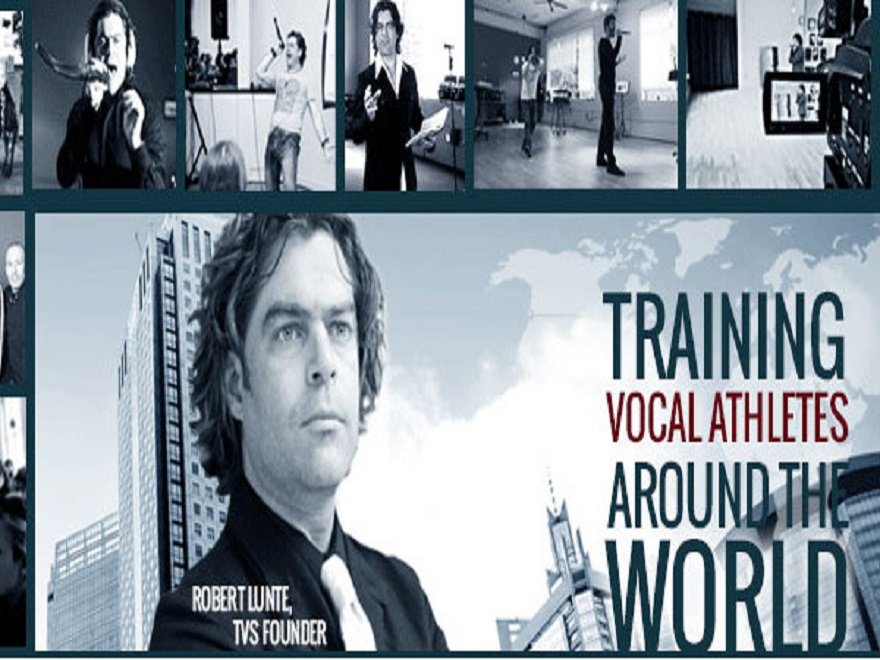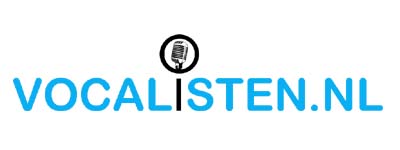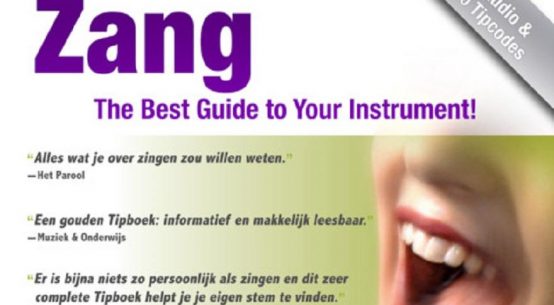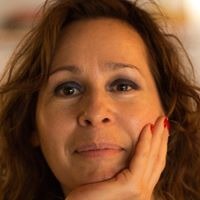
Op 14 juni 2014 organiseert zangcoach Rob van den Biggelaar (Eigenaar zangstudio ROBB) een interactieve masterclass / workshop met collega zangcoach en pionier Robert Lunte (Seattle, USA).
Deze masterclass vind plaats in een locatie nabij Breda. Nu vinden er doorgaans veel van deze dagen plaats, maar deze is bijzonder. Robert Lunte (eigenaar van “The Vocalist Studio” kortweg TVS) heeft namelijk een hedendaagse en baanbrekende zangmethode bedacht, de TVS methode, welke internationaal in meer dan 9 landen actief wordt gebruikt door collega zangcoaches. Het is baanbrekend te noemen, omdat deze zangmethode weer andere aspecten behandeld dan andere bekende zangmethodes zoals EVTS en CVT o.a.: unieke trainingroutines en workflows bruikbaar voor de zangtraining voor elk niveau, het zogenaamde afstemmen en kalibreren van formanten en boventonen, het trainen van het overbruggen van de zogenaamde passagio van het lagere naar het hogere register, klinkermodificaties, etc. Robert Lunte was tevens een van de eerste zangcoaches die zanglessen via Skype aanbood. Zangcoach Rob van den Biggelaar zal deze zomer afstuderen als Master Course Instructor (MCI) van deze methode voor het gebied Nederland en België. Op zaterdag 14 juni 2014 zal deze methode, bruikbaar in alle stijlen van lichte muziek, voor het eerst worden geïntroduceerd in Nederland.
Meer informatie omtrent deze interactieve masterclass is te vinden via de site; http://tinyurl.com/TVSEventUlvenhout Inschrijven voor de interactieve masterclass kan ook via deze site of door een mail te sturen naar info@robvandenbiggelaar.nl
Wij spraken Robert Lunte en Rob van den Biggelaar over deze nieuwe methode.
Hieronder volgt een uitgebreid verslag van het interview.
What is the Vocalist Studio?
About TVS: The Vocalist Studio offers one of the leading voice techniques and methodologies in the world for contemporary voice study. Robert Lunte and has developed one of the most innovative sets of techniques and products for singers recognized anywhere. In particular, TVS training will unveil the mystery of how the voice really works and show you a path to results that were missing in other vocal programs. For beginners of singing, TVS establishes the best foundation for singers that seek to get serious about their training and finally experience results. Most beginning students enjoy huge results in less than 30-‐90 days of serious training. For experienced students, TVS is the first choice to take what you know about singing technique to the next level. Many people that have spent time training other, remedial programs, come to TVS for more challenging and advanced instruction. Always cutting the edge of innovation and technology, TVS is an innovator in the industry and is setting new standards on what voice training can be and how it can be delivered. If you are interested in unlocking the mystery and confusion around vocal technique and finally get results. TVS has the answers for you. Below are common questions people ask about training TVS Methodology.
Does TVS Train Beginners?
Yes, we take singers from all levels of experience, beginners to touring professionals.
What are the most important skills singers really need to train?
All singers have unique needs and wants according to their style and artistic interests, however at The Vocalist Studio we believe that all singers need and want two primary skills that can only be learned through vocal training. The two skills are referred to as “Bridging & Connecting”.
Simply stated, “bridging” is the ability to sing seamlessly from the chest voice to the head voice without experiencing any vocal strain (activation of the constrictor muscles) or struggling with vocal instability, commonly referred to as “vocal breaking”. In order to sing seamlessly, students of singing technique must master the skill of “bridging” the two primary vocal registers. TVS is recognized foremost for being the ‘go to’ method to experience quick results with register bridging.
After bridging skills are developed, singers must then learn to “connect” in the head voice. “Connecting” is a TVS term that refers to training the ability to sing in the head voice without sounding weak, windy or with a feminine, undesirable Falsetto sound. Falsetto vocal mode is the natural instinct for the body when singing or producing any vocal sound in the head voice. Therefore, singers must train to replace this sound with a new, exotic vocal mode known as “vocal twang” that makes the head voice sound like a chest voice belt. Learning to “connect” is learning to master an illusion that makes the audience think that the singer is singing high notes in their speech voice, when in fact, they are singing with an exotic vocal mode known as “twang”. Twang vocal mode is further accompanied by specialized larynx dampening positions, formant tuning and the proper use of vowels to produce the desired, full “chest-‐like” effect in the head voice. TVS techniques and training routines are the world’s leading techniques to achieve muscular strength and coordination for incredible head voice work. Learning to “bridge and connect” is the backbone of your trained skills as a singer and is the main purpose of vocal training in the first place.
How do I know if I am getting what I need from my vocal training?
If you are currently engaged in a vocal training program that has not introduced you to the concepts of “bridging” the voice registers, and you are not making progress after practicing approximately 30-‐90 days, your training is not going to work for you. To truly get amazing gains, you must be engaged in vocal training that does address topics of discussion such as; “vocal modes”, “tuning formants”, “learning to Twang”, “intrinsic anchoring”, “laryngeal dampening”, “vowel modification”, training with “specialized onsets” and offers training content (scales & workouts) to practice with. Training programs that do not discuss these concepts and do not offer you training content to practice, will not help you to achieve the the bridging and connecting mission of good vocal training.
Additionally, if you are involved in voice training that advocates concepts such as, “keeping the larynx balanced” or “neutral” at all times, regardless of genre’ and style, you simply are not going to get the strength in your intrinsic musculature to ever sing full “chest-‐like” head voice sounds. “Sing like you Speak” methods that claim that great singing can be achieved with physical configurations equal to speech are completely, utterly wrong. The way we use the voice when we sing singing is radically different in physiology and acoustics from the way we use the voice when we speak. Also, very common to “sing like you speak” training methods, is the introduction of fear regarding the feeling of any musculature in the larynx when training. If you are practicing a method that has you feeling reluctant to contract muscle and feel movement in your larynx when your training, you are on a path that has long since been proven obsolete.
Train with programs and teachers that regularly publish books, blogs and are involved in research of not one, but all vocal training methods and ideas. Any program that claims to have all the answers for any and all situations is delusional and arrogant. Chances are, that same arrogance is preventing that program from learning what it needs to learn to evolve and adapt to a rapidly changing industry of ideas and techniques.
Lastly, train with voice teachers that can demonstrate and produce the vocal sounds they are teaching. If your voice teacher cannot lead by example, then how can you expect that same person to be able to teach you how to do it?
What results do students of TVS training typically all experience?
- Seamless Bridging of the chest & head voice for incredible range and freedom from strain.
- Replace Falsetto (windy) vocal sounds in the head voice with a full and convincing sound.
- Learn how to produce vocal distortion (rasp) without damaging your voice while sounding incredible.
- Learn how to command and control your formant with vowel modification to gain an advantage by really understanding how the acoustics of singing works.
- Lean about vocal modes; physical modes that represent unique physical configurations of the larynx and acoustic modes, “packages” of technical components that influence sound color and creative interpretation.
- Accelerated training progress from the “TVS Training Work Flows”. The step by step training routines found only in TVS Methodology make training efficient and easy to understand.
- Learn how to rapidly accelerate your physical strength and coordination for singing by learning “The 8 TVS Specialized Onsets”, and learn how to use the TVS onsets to trouble-‐shoot vocal problems.
- TVS students train from the renown, comprehensive TVS training program titled, “The Four Pillars of Singing” (TFPOS Table of Contents). TFPOS offers training routines that tell you exactly what to do, how to do it and how much. Over 382 audio and high definition video files exceeding over 6.5 GB of training content accompany a 400 page, full color book. “The Four Pillars of Singing” is unmatched in the industry for its quality and quantity of content. “The Four Pillars of Singing” enjoys 100%, 5-‐star reviews from amazon.com and the TVS store from real clients of TVS. Click on the link above and read the reviews!
- Learn how to use spectrum software to create stability in your singing and produce rich overtones in the voice that can literally amaze audiences from any genre’. Larynx dampening is one of the biggest secrets to making your voice sound beautiful, powerful, soulful and sonorous. It is probably the most important key to excellence in sound color and timbre in your singing.
- Learn the difference between “Light Mass Singing” vs “Medium Mass Singing” and why this may be the missing link that will unlock the “pushing” in your singing and set your voice free in less than 10 minutes.
- Understand the physiological and acoustic components required to produce a high performance phonation and then learn how to train those components into sequential training work flows to create a level of muscle memory, power and balance never before seen from any other vocal training system in the world.
Is TVS only about teaching rock style singing?
NO! TVS is not only about teaching Rock style singing. TVS techniques are applied to every genre and style of music by artists of all backgrounds around the world.
What is the main focus of the TVS Method?
TVS Methodology tends to focus on the following core principles currently:
- Assigning a “mass” to each phonation:
Identifying mass in each phonation gives singers a way of balancing their singing and prevents the body from pushing and constricting. Learning to perceive your singing in the context of “mass”, empowers the singer and gives command and control back to the body, instead of the body commanding and controlling you. - Training Bridging and Connecting Skills:
TVS Methodology focuses hard and fast on teaching students the skills they need and want the most; learning to seamlessly bridge the vocal break and sing high notes with convincing, full tone. TVS is recognized as the world leader in developing techniques and training routines to develop these two critical skills. - Grouping Technical Components for High Performance Singing:
TVS Methodology groups physical and acoustic components that make up a high performance singing voice. Anecdotal and metaphoric voice teaching ideas have no place in the “TVS Phonation Package”, the sum total of all the technical components that need to be understood and trained to achieve a high performance singing voice. When you know the top technical details that are needed to sing great, the act of vocal training no longer remains a mystery and the details of what you are suppose to be listening for and working on are clear. The mission becomes clear and to the point. - Training Work Flows:
A “work flow” is the sequential steps to any process. TVS Training Work flows are training and practice routines that sort the technical components of a “high performance phonation” into sequential steps to maximize efficiency in training. The process of training vocal technique is radically improved and progress accelerated when training routines are clarified with training work flows. (step 1, step 2, step 2, etc). - Mastery of Specialized Onsets:
In voice technique language, “onset” means the beginning. TVS has developed 8 essential, specialized onsets, or ways of beginning your singing, that are used to isolate key muscles for strength building and coordination. These same specialized onsets are also used by TVS students to trouble-‐shoot vocal problems. The 8 Specialized Onsets are a cornerstone to TVS Methodology. - Formant Tuning and Training with Spectrum Graph Software:
Training formants is the deepest mystery in all vocal technique because it tends to be very complicated to understand. TVS Methodology has developed a practical way to understand and train vocal formants without the complication. When training TVS, spectrum software is also utilized to engage the benefits of learning with the power of vision. When you can see the colors and harmonics of your voice in real time, you can more quickly tune your voice and get tangible results quicker. - Vocal Modes:
TVS is one of a very few Methodologies that has embraced the practice of modal pedagogy, or the practice of categorizing vocal sounds into unique physical or acoustic “modes” for the purpose of creating more understanding of how the voice works and how to teach singing technique. - Vowel Modification:
TVS is the only vocal training Method to take the practice of vowel modification to a whole new level by introducing vowel modification formulas to accompany the training routines found in “The Four Pillars of Singing”. Vowel modification formulas are used to train the proper acoustics for bridging and connecting. Vowel modification formulas are also used for resistance training to build more muscle strength, dexterity and coordination through the vocal passaggio, an approach to vowel modification not found in any other program. - Training with Amplification:
From the beginning, a TVS has always championed the benefits found in training contemporary students with amplification. Apart from learning how to use the microphone and the tools of the trade, training with amplification increases the ability to hear the harmonic colors in singing and helps make vocal training fun, energetic and exciting.
How long will it take before I begin to see progress in my singing?
It is very common for a TVS student to experience an exponential leap forward in range, power and quality of sound in as little as 30-60 days, for many people, much earlier. At TVS, we hold a high value in accelerated learning; we capitalize on your strengths and dive right into your weaknesses. By doing so, we create an agenda that is the quickest path to success for your individual voice. At TVS, we know the best way to insure a lasting working relationship, is to get the client what they need and want as soon as possible and let the world hear it.
Ok, how do I begin my training at TV?
We recommend that you start by investing in a copy of “The Four Pillars of Singing” (The New Student Package) and immediately begin consuming the content and start training! For students in the Netherlands that are ready for a more serious commitment, private lessons with Rob van den Biggelaar at Zangstudio ROBB (www.robvandenbiggelaar.nl) and over Skype webcam (www.skypezanglessen.nl) are available.
We understand that invites to do more vocal workshops is growing… if a vocalist attends your “Training Vocal Athletes” Workshop, what will they be “stepping” into?
The demand for the TVS workshops are coming from the same problem that has supported the studio in Seattle … there just isn’t enough information or teachers out there that truly understand contemporary singers, their needs and requirements… especially rockers that have a unique repertoire of high velocity sounds like belts, extreme screaming, high pitch screams and distortion. There seem to be more teachers that serve this kind of vocalist in North America, but in Roberts’ opinion in Europe its relatively small… so there seems to be a lot of interest in Europe for TVS.
A workshop usually consists of a 3-‐4 hour workshop/demonstration of the techniques with audience participation, demonstrations and supporting materials… Workshop participants may also book private lessons with Robert Lunte after the workshop. He wants to leave the workshop clients feeling like they learned a lot, got a lot of personal attention and had fun.
What do you think is the future of modern voice pedagogy?
Trends…? The future of modern pedagogy will be a continuation of what we are already beginning to see… the emergence of legitimate voice teachers and training systems that provide information for people that want to sing in styles outside of the Classical medium. New innovations such as technology for singers, web based lessons on web cams and research on vocal distortion and screaming are examples of some cutting-‐edge activities that will continue to grow. Its an exciting time for voice pedagogy as the contemporary styles and teachers are finally beginning to get recognition and take the “stage”… This is making the traditional Classical studio more of a coaching experience for a specific genre and no longer the authority on proper vocal technique for all singers.
Website Robert Lunte: www.thevocaliststudio.com
Website Rob van den Biggelaar: www.robvandenbiggelaar.nl


